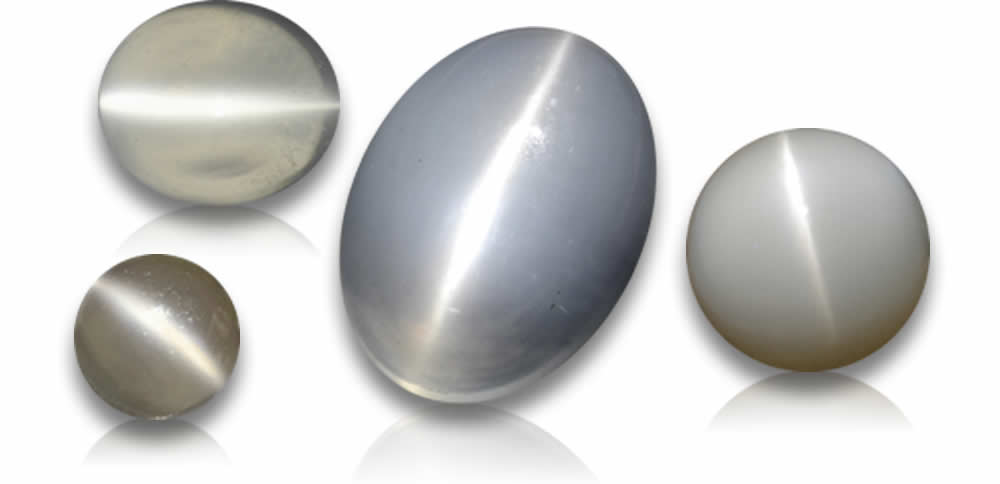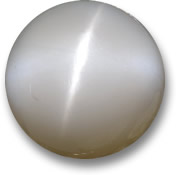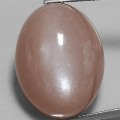Cat's Eye Moonstone Gemstone Information

About Cat's Eye Moonstone - History and Introduction
Cat's eye moonstone is a gemstone known for its mesmerizing optical phenomenon, reminiscent of a feline's eye glimmering in the light. This unique variety of moonstone shows a distinct chatoyancy, creating a narrow band of light that moves across its surface when viewed from different angles. With its soft, iridescent hues ranging from pale blue to shimmering grey, cat's eye moonstone captivates jewelry enthusiasts and carries cultural and metaphysical significance.
Beyond chatoyancy, cat's eye moonstone also displays adularescence, the milky sheen or glowing light that seems to come from beneath the surface - something moonstone is famous for. Isn't it interesting how nature creates these effects?
Moonstone is the best-known gem-quality potassium feldspar. Its name comes from the almost magical, bluish-white shimmer that looks like moonlight. This shimmer results from alternating layers of orthoclase and albite, which interfere with light entering the stone, reflecting it back in a scattered, fantastic schiller.
The sheen often appears in white, blue, or blue-orange, paired with the cat's eye reflection. Finding both adularescence and chatoyancy in one stone is quite rare. Top-quality pieces can even show a 'three-dimensional' depth of color thanks to moonstone's strong adularescence.

Identifying Cat's Eye Moonstone
Cat's eye moonstone stands out from other moonstone varieties due to its chatoyancy. As a potassium aluminum silicate, its composition helps with identification too. Other gems that look similar usually lack the phenomenal adularescence, making it straightforward to spot. The simplest test? Check hardness - most look-alikes are either harder, like cat's eye quartz, or softer, like cat's eye apatite.
Cat's Eye Moonstone Origin and Gemstone Sources
Cat's eye moonstone is extremely rare and comes from the same mines as other moonstones. Key deposits are in Sri Lanka and India. Sri Lanka produces the highly sought-after bluish moonstone, while India leads in 'blue-sheen moonstone'. Other sources include Australia, Brazil, Myanmar (Burma), Madagascar, Mexico, Norway, Switzerland, Tanzania, and the United States.
Buying Cat's Eye Moonstone - Value Factors
Cat's Eye Moonstone Color
Moonstone is usually colorless but can appear in various shades. It often has a silvery sheen with base colors like gray, cream, mocha, brown, yellow, orange, green, pink, blue, and white. The most desirable are those with a blue sheen and a white to colorless body. Deep-blue moonstone holds the highest value.
Cat's Eye Moonstone Clarity and Luster
When held to light, cat's eye moonstone shows translucent clarity. Transparent specimens are more valuable. It has an appealing luster, from vitreous to pearly. Some rare moonstones exhibit asterism and are called star moonstone - exceptionally rare and highly prized.
Cat's Eye Moonstone Cut and Shape
Cat's eye moonstone is always cabochon-cut to highlight chatoyancy. The cut orientation maximizes schiller and adularescence, often with high domes. Ovals are common to preserve carat weight. Stones with clear, distinct 'eyes' are the most valuable.
Cat's Eye Moonstone Treatment
Cat's eye moonstone isn't treated or enhanced. That said, there are reports of some brighter blue moonstones being coated for color improvement.
Cat's Eye Moonstone Gemological Properties
| Chemical Formula | KAlSi3O8, Potassium aluminum silicate |
|---|---|
| Crystal Structure | Monoclinic, prismatic |
| Color | Colorless, yellow, pale sheen |
| Hardness | 6 to 6.5 on the Mohs scale |
| Refractive Index | 1.518 to 1.526 |
| Density | 2.56 to 2.59 |
| Cleavage | Perfect |
| Transparency | Transparent to translucent |
| Double Refraction or Birefringence | -0.008 |
| Luster | Vitreous to pearly |
| Fluorescence | Weak; bluish, orange |
Please refer to our Gemstone Glossary for details on gemology-related terms.
Cat's Eye Moonstone Varieties or Similar Gemstones

Cat's eye moonstone is part of the vast feldspar mineral family, which makes up about 60% of Earth's crust. Feldspars divide into potassium and plagioclase groups. All moonstones are potassium feldspars, like amazonite and orthoclase. Gems confused with moonstone include 'rainbow moonstone', which is actually labradorite, a plagioclase feldspar.
Most Popular Similar or Related Trade Names & Gemstones
Moonstone gemstone information and properties, star moonstone gemstone details, rainbow moonstone variety facts, and sunstone are the most recognized.
Lesser-Known Similar or Related Trade Names & Gemstones
Orthoclase, amazonite, labradorite, andesine, andesine-labradorite, and oligoclase.
Cat's Eye Moonstone Mythology, Metaphysical, and Crystal Healing Powers
Cat's eye moonstone shares legends and energies with other moonstones. Few gems have as much lore. Revered for thousands of years across cultures, Hindu legend says moonstone formed from moonbeams. Once, people believed holding one in your mouth during a full moon revealed your future. In India, it's a sacred stone thought to bring good fortune. Arab women sew it into garments for fertility.
In ancient Rome, moonstone linked to the moon, formed from moonlight drops. It embodies romance, femininity, intuition, dreams, emotion, and love. Lovers prize it for arousing tenderness and passion. Couples use it to foretell their future. It's June's birthstone and Pisces' zodiac gem. Physically, it's thought to ease headaches and backaches.
For more detailed insights, explore our moonstone lore and mythological history.
Disclaimer: Metaphysical and Alternative Crystal Healing Powers and Properties are not to be taken as confirmed advice. Traditional, Ceremonial and Mythological Gemstone Lore is collected from various resources and is not the sole opinion of the author. This information is not to replace the advice of your doctor. Should you have any medical conditions, please see a licensed medical practitioner. The author does not guarantee any claims or statements of healing or astrological birthstone powers and cannot be held liable under any circumstances.
Cat's Eye Moonstone Gemstone and Jewelry Design Ideas
Though not as hard as many jewelry gems, cat's eye moonstone is popular for jewelry, worn since ancient Greek and Roman times. Stick to protective designs like earrings, pendants, pins, and brooches. For rings, wear occasionally to avoid scratches. It's sensitive to pressure, so handle setting carefully. Both men and women like cat's eyes - great for cufflinks or tie-tacks.
Note: Buy colored gemstones by size and not by carat weight. Colored stones vary in size-to-weight ratio. Some stones are larger and others are smaller than diamond by weight in comparison.
Cat's Eye Moonstone Gemstone and Jewelry Care and Cleaning

Cat's eye moonstone isn't very hard, so take care to keep it beautiful. Skip harsh chemicals like bleach or sulfuric acid. Avoid ultrasonic cleaners or steamers.
Use mild soap and a soft cloth to wipe it down. Rinse well with warm water to remove residue that could dull its luster.
It's sensitive to pressure and temperature changes, so avoid extremes. Don't use tension mountings. Remove jewelry before sports or chores. Store separately, wrapped in soft cloth or in a lined box.
Frequently Asked Questions
What is cat's eye moonstone?
Cat's eye moonstone is a variety of moonstone that exhibits chatoyancy, a cat's eye effect, along with adularescence, a milky sheen.
How can I identify genuine cat's eye moonstone?
Look for chatoyancy and adularescence; test hardness (6-6.5 on Mohs) or check composition as potassium aluminum silicate.
Where does cat's eye moonstone come from?
Main sources are Sri Lanka and India, with others in Australia, Brazil, and more.
Is cat's eye moonstone treated?
Typically no, but some blue specimens may have coatings for color enhancement.
How should I care for cat's eye moonstone jewelry?
Clean with mild soap, avoid harsh chemicals and ultrasonics, store separately, and remove before activities.

